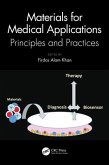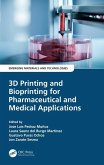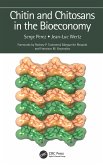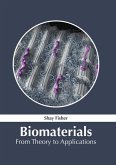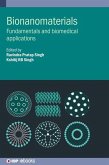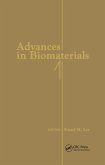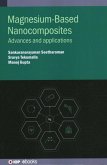Zhaochun Yang
Material Modeling in Finite Element Analysis
Zhaochun Yang
Material Modeling in Finite Element Analysis
- Gebundenes Buch
- Merkliste
- Auf die Merkliste
- Bewerten Bewerten
- Teilen
- Produkt teilen
- Produkterinnerung
- Produkterinnerung
Finite element analysis has been widely applied in mechanical, civil, and biomedical design. This book aims to provide the readers with comprehensive views of various material models through practical examples, which would help readers better understand various materials and build appropriate material models in the finite element analysis.
Andere Kunden interessierten sich auch für
![Materials for Medical Applications Materials for Medical Applications]() Materials for Medical Applications174,99 €
Materials for Medical Applications174,99 €![3D Printing and Bioprinting for Pharmaceutical and Medical Applications 3D Printing and Bioprinting for Pharmaceutical and Medical Applications]() 3D Printing and Bioprinting for Pharmaceutical and Medical Applications174,99 €
3D Printing and Bioprinting for Pharmaceutical and Medical Applications174,99 €![Chitin and Chitosans in the Bioeconomy Chitin and Chitosans in the Bioeconomy]() Serge PerezChitin and Chitosans in the Bioeconomy154,99 €
Serge PerezChitin and Chitosans in the Bioeconomy154,99 €![Biomaterials: From Theory to Applications Biomaterials: From Theory to Applications]() Biomaterials: From Theory to Applications144,99 €
Biomaterials: From Theory to Applications144,99 €![Bionanomaterials Bionanomaterials]() Bionanomaterials207,99 €
Bionanomaterials207,99 €![Advances in Biomaterials 1 Advances in Biomaterials 1]() Stuart M LeeAdvances in Biomaterials 1153,99 €
Stuart M LeeAdvances in Biomaterials 1153,99 €![Magnesium-Based Nanocomposites Magnesium-Based Nanocomposites]() Manoj GuptaMagnesium-Based Nanocomposites207,99 €
Manoj GuptaMagnesium-Based Nanocomposites207,99 €-
-
-
Finite element analysis has been widely applied in mechanical, civil, and biomedical design. This book aims to provide the readers with comprehensive views of various material models through practical examples, which would help readers better understand various materials and build appropriate material models in the finite element analysis.
Hinweis: Dieser Artikel kann nur an eine deutsche Lieferadresse ausgeliefert werden.
Hinweis: Dieser Artikel kann nur an eine deutsche Lieferadresse ausgeliefert werden.
Produktdetails
- Produktdetails
- Verlag: CRC Press
- 2nd edition
- Seitenzahl: 308
- Erscheinungstermin: 9. November 2023
- Englisch
- Abmessung: 234mm x 156mm x 19mm
- Gewicht: 626g
- ISBN-13: 9781032566023
- ISBN-10: 1032566027
- Artikelnr.: 68711308
- Herstellerkennzeichnung
- Libri GmbH
- Europaallee 1
- 36244 Bad Hersfeld
- gpsr@libri.de
- Verlag: CRC Press
- 2nd edition
- Seitenzahl: 308
- Erscheinungstermin: 9. November 2023
- Englisch
- Abmessung: 234mm x 156mm x 19mm
- Gewicht: 626g
- ISBN-13: 9781032566023
- ISBN-10: 1032566027
- Artikelnr.: 68711308
- Herstellerkennzeichnung
- Libri GmbH
- Europaallee 1
- 36244 Bad Hersfeld
- gpsr@libri.de
Zhaochun Yang received his PhD in Mechanical Engineering from the University of Pittsburgh in 2004. Since 2005, he has worked for big companies and national labs such as Nation Energy Technology Laboratory. He has been in the field of finite element analysis for over 20 years and has gained much experience, especially in material modeling. Up to now, he has published 12 journal papers and 3 books.
Chapter 1 Introduction
Part 1 METAL
Chapter 2 Structure and Material Properties of Metal
2.1 Structure of Metal
2.2 Elasticity and Plasticity of Metal
Chapter 3 Some Plastic Material Models of Metals
3.1 Introduction of Plasticity
3.2 Nonlinear Kinematic Hardening
Chapter 4 Material Properties as Function of Time
4.1 Introduction of Viscoplasticity
4.2 Creep
4.3 Discussion of Viscoplasticity and Creep
Chapter 5 Influence of Temperature on Material Properties
5.1 Temperature Dependency of Material Properties
5.2 Simulation of Combustion Chamber under Different Temperatures
Chapter 6 Subroutine UserMat
6.1 UserMat Development
6.2 UserMat of Strain-Hardening Model
Part 2 POLYMERS
Chapter 7 Structure and Features of Polymer
7.1 Structure of Polymer
7.2 Features of Polymer
Chapter 8 Hyperelasticity
8.1 Some Widely Used Hyperelastic Models
8.2 Stability Discussion
8.3 Curve-Fitting of Material Parameters from Experimental Data
Chapter 9 Viscoelasticity of Polymers
9.1 Linear Viscoelastic Models
9.2 Shift Functions
Chapter 10 Eight-Chain Based Viscoplasticity Models
10.1 Bergstrom-Boyce Model
10.2 Simulation of Small Punch Test
Chapter 11 Mullins Effect
11.1 Introduction of Mullins Effect
11.2 Ogden-Roxburgh Mullins Effect Model
11.3 Simulation of a Rubber Tire with the Mullins Effect
Chapter 12 UserHyper for Hyperelastic Materials
12.1 Introduction of Subroutine UserHyper
12.2 Simulation of Veronda-Westman Model
Part 3 SOIL
Chapter 13 Soil Introduction
13.1 Soil Structure
13.2 Soil Parameters
Chapter 14 Cam Clay Model
14.1 Introduction of Modified Cam Clay Model
14.2 Modified Cam Clay in ANSYS
14.3 Simulation of Soil Excavation
14.4 Simulation of A Tower on the Ground by Modified Cam Clay Model
Chapter 15 Drucker-Prager Model
15.1 Introduction of Drucker-Prager Model
15.2 Simulation of Concrete Slump Test
15.3 Study of Soil-Arch Interaction
Chapter 16 Mohr-Coulomb Model
16.1 Introduction of Mohr-Coulomb Model
16.2 Mohr-Coulomb Model in ANSYS
16.3 Concrete Slump Test
16.4 Study of Slope Stability
Chapter 17 Jointed Rock Model
17.1 Jointed Rock Model
17.2 Definition of Jointed Rock Model in ANSYS
17.3 Simulation of Tunnel Excavation
Chapter 18 Consolidation of Soils
18.1 Consolidation of Soils
18.2 Modeling Porous Media in ANSYS
18.3 Simulation of Terzaghi's Problem
18.4 Simulation of Consolidation of Three-Well Zone
Part 4 MODERN MATERIALS
Chapter 19 Composite Materials
19.1 Introduction of Composite Materials
19.2 Modeling Composites in ANSYS
19.3 Simulation of Composite Structure in Failure Test
19.4 Simulation of Crack Growth in Single Leg Bending Problem
Chapter 20 Functionally Graded Material
20.1 Introduction of Functionally Graded Material
20.2 Material Model of Functionally Graded Material
20.3 Simulation of Spur Gear with Functionally Graded Material
Chapter 21 Shape Memory Alloys
21.1 Structures and Various Material Models
21.2 Simulation of Orthodontic Wire
21.3 Simulation of Vacuum Tight Shape Memory Flange
Chapter 22 Simulation of Piezoelectricity
22.1 Introduction of Piezoelectricity
22.2 Structures and Mechanical Behaviors of Piezoelectric Materials
22.3 Constitutive Equation of Piezoelectricity
22.4 Simulation of Piezoelectric Accelerometer
Chapter 23 Nano Materials
23.1 Introduction of Nano
23.2 Determination of Young's Modulus of Fe Particles
Part 5 Retrospective
Chapter 24 Retrospective
Appendix 1 Input File of Curve-Fitting of the Chaboche Model in Section 3.2
Appendix 2 Input File of the Ratchetting Model in Section 3.2
Appendix 3 Input File of the Forming Process Model in Section 4.1
Appendix 4 Input File of the Bolt Model under Pretension in Section 4.2
Appendix 5 Input File of the Combustion Chamber Model in Section 5.2
Appendix 6 UserMat of Strain-Hardening Model in Section 6.2
Appendix 7 Input File of the Uniaxial Test with Strain-Hardening Model in
Section 6.2
Appendix 8 Input File of Curve-Fitting of the Ogden Model in Section 8.3
Appendix 9 Input File of the Liver Soft Tissue Model in Section 9.1
Appendix 10 Input File of the Stress Evolution of Glass Tube in Section 9.2
Appendix 11 Input File of the Small Punch Test in Section 10.2
Appendix 12 Input File of the Rubber Tire Damage Model in Section 11.3
Appendix 13 Input File of the Breast Tumor Model in Section 12.2
Appendix 14 Input File of the Soil Excavation in Section 14.3
Appendix 15 Input File of the Tower Subsidence Model in Section 14.4
Appendix 16 Input File of the Concrete Slump Test in Section 15.2
Appendix 17 Input File of the Soil-Arch Interaction Model in Section 15.3
Appendix 18 Input File of the Concrete Slump Test in Section 16.3
Appendix 19 Input File of the Slope Stability Model in Section 16.4
Appendix 20 Input File of the Tunnel Excavation Model in Section 17.3
Appendix 21 Input File of One Dimensional Terzaghi's Problem in Section
18.3
Appendix 22 Input File of the Settlement Model in Section 18.4
Appendix 23 Input File of the Composite Damage Model in Section 19.3
Appendix 24 Input File of the SLB Model in Section 19.4
Appendix 25 Input File of the Spur Gear Model with FGM in Section 20.3
Appendix 26 Input File of the Orthodontic Wire Model in Section 21.2
Appendix 27 Input File of the Vacuum Tight Shape Memory Flange Model in
Section 21.3
Appendix 28 Input File of the Piezoelectric Microaccelerometer Model in
Section 22.4
Appendix 29 Input File of the Contact Model in Section 23.2
Part 1 METAL
Chapter 2 Structure and Material Properties of Metal
2.1 Structure of Metal
2.2 Elasticity and Plasticity of Metal
Chapter 3 Some Plastic Material Models of Metals
3.1 Introduction of Plasticity
3.2 Nonlinear Kinematic Hardening
Chapter 4 Material Properties as Function of Time
4.1 Introduction of Viscoplasticity
4.2 Creep
4.3 Discussion of Viscoplasticity and Creep
Chapter 5 Influence of Temperature on Material Properties
5.1 Temperature Dependency of Material Properties
5.2 Simulation of Combustion Chamber under Different Temperatures
Chapter 6 Subroutine UserMat
6.1 UserMat Development
6.2 UserMat of Strain-Hardening Model
Part 2 POLYMERS
Chapter 7 Structure and Features of Polymer
7.1 Structure of Polymer
7.2 Features of Polymer
Chapter 8 Hyperelasticity
8.1 Some Widely Used Hyperelastic Models
8.2 Stability Discussion
8.3 Curve-Fitting of Material Parameters from Experimental Data
Chapter 9 Viscoelasticity of Polymers
9.1 Linear Viscoelastic Models
9.2 Shift Functions
Chapter 10 Eight-Chain Based Viscoplasticity Models
10.1 Bergstrom-Boyce Model
10.2 Simulation of Small Punch Test
Chapter 11 Mullins Effect
11.1 Introduction of Mullins Effect
11.2 Ogden-Roxburgh Mullins Effect Model
11.3 Simulation of a Rubber Tire with the Mullins Effect
Chapter 12 UserHyper for Hyperelastic Materials
12.1 Introduction of Subroutine UserHyper
12.2 Simulation of Veronda-Westman Model
Part 3 SOIL
Chapter 13 Soil Introduction
13.1 Soil Structure
13.2 Soil Parameters
Chapter 14 Cam Clay Model
14.1 Introduction of Modified Cam Clay Model
14.2 Modified Cam Clay in ANSYS
14.3 Simulation of Soil Excavation
14.4 Simulation of A Tower on the Ground by Modified Cam Clay Model
Chapter 15 Drucker-Prager Model
15.1 Introduction of Drucker-Prager Model
15.2 Simulation of Concrete Slump Test
15.3 Study of Soil-Arch Interaction
Chapter 16 Mohr-Coulomb Model
16.1 Introduction of Mohr-Coulomb Model
16.2 Mohr-Coulomb Model in ANSYS
16.3 Concrete Slump Test
16.4 Study of Slope Stability
Chapter 17 Jointed Rock Model
17.1 Jointed Rock Model
17.2 Definition of Jointed Rock Model in ANSYS
17.3 Simulation of Tunnel Excavation
Chapter 18 Consolidation of Soils
18.1 Consolidation of Soils
18.2 Modeling Porous Media in ANSYS
18.3 Simulation of Terzaghi's Problem
18.4 Simulation of Consolidation of Three-Well Zone
Part 4 MODERN MATERIALS
Chapter 19 Composite Materials
19.1 Introduction of Composite Materials
19.2 Modeling Composites in ANSYS
19.3 Simulation of Composite Structure in Failure Test
19.4 Simulation of Crack Growth in Single Leg Bending Problem
Chapter 20 Functionally Graded Material
20.1 Introduction of Functionally Graded Material
20.2 Material Model of Functionally Graded Material
20.3 Simulation of Spur Gear with Functionally Graded Material
Chapter 21 Shape Memory Alloys
21.1 Structures and Various Material Models
21.2 Simulation of Orthodontic Wire
21.3 Simulation of Vacuum Tight Shape Memory Flange
Chapter 22 Simulation of Piezoelectricity
22.1 Introduction of Piezoelectricity
22.2 Structures and Mechanical Behaviors of Piezoelectric Materials
22.3 Constitutive Equation of Piezoelectricity
22.4 Simulation of Piezoelectric Accelerometer
Chapter 23 Nano Materials
23.1 Introduction of Nano
23.2 Determination of Young's Modulus of Fe Particles
Part 5 Retrospective
Chapter 24 Retrospective
Appendix 1 Input File of Curve-Fitting of the Chaboche Model in Section 3.2
Appendix 2 Input File of the Ratchetting Model in Section 3.2
Appendix 3 Input File of the Forming Process Model in Section 4.1
Appendix 4 Input File of the Bolt Model under Pretension in Section 4.2
Appendix 5 Input File of the Combustion Chamber Model in Section 5.2
Appendix 6 UserMat of Strain-Hardening Model in Section 6.2
Appendix 7 Input File of the Uniaxial Test with Strain-Hardening Model in
Section 6.2
Appendix 8 Input File of Curve-Fitting of the Ogden Model in Section 8.3
Appendix 9 Input File of the Liver Soft Tissue Model in Section 9.1
Appendix 10 Input File of the Stress Evolution of Glass Tube in Section 9.2
Appendix 11 Input File of the Small Punch Test in Section 10.2
Appendix 12 Input File of the Rubber Tire Damage Model in Section 11.3
Appendix 13 Input File of the Breast Tumor Model in Section 12.2
Appendix 14 Input File of the Soil Excavation in Section 14.3
Appendix 15 Input File of the Tower Subsidence Model in Section 14.4
Appendix 16 Input File of the Concrete Slump Test in Section 15.2
Appendix 17 Input File of the Soil-Arch Interaction Model in Section 15.3
Appendix 18 Input File of the Concrete Slump Test in Section 16.3
Appendix 19 Input File of the Slope Stability Model in Section 16.4
Appendix 20 Input File of the Tunnel Excavation Model in Section 17.3
Appendix 21 Input File of One Dimensional Terzaghi's Problem in Section
18.3
Appendix 22 Input File of the Settlement Model in Section 18.4
Appendix 23 Input File of the Composite Damage Model in Section 19.3
Appendix 24 Input File of the SLB Model in Section 19.4
Appendix 25 Input File of the Spur Gear Model with FGM in Section 20.3
Appendix 26 Input File of the Orthodontic Wire Model in Section 21.2
Appendix 27 Input File of the Vacuum Tight Shape Memory Flange Model in
Section 21.3
Appendix 28 Input File of the Piezoelectric Microaccelerometer Model in
Section 22.4
Appendix 29 Input File of the Contact Model in Section 23.2
Chapter 1 Introduction
Part 1 METAL
Chapter 2 Structure and Material Properties of Metal
2.1 Structure of Metal
2.2 Elasticity and Plasticity of Metal
Chapter 3 Some Plastic Material Models of Metals
3.1 Introduction of Plasticity
3.2 Nonlinear Kinematic Hardening
Chapter 4 Material Properties as Function of Time
4.1 Introduction of Viscoplasticity
4.2 Creep
4.3 Discussion of Viscoplasticity and Creep
Chapter 5 Influence of Temperature on Material Properties
5.1 Temperature Dependency of Material Properties
5.2 Simulation of Combustion Chamber under Different Temperatures
Chapter 6 Subroutine UserMat
6.1 UserMat Development
6.2 UserMat of Strain-Hardening Model
Part 2 POLYMERS
Chapter 7 Structure and Features of Polymer
7.1 Structure of Polymer
7.2 Features of Polymer
Chapter 8 Hyperelasticity
8.1 Some Widely Used Hyperelastic Models
8.2 Stability Discussion
8.3 Curve-Fitting of Material Parameters from Experimental Data
Chapter 9 Viscoelasticity of Polymers
9.1 Linear Viscoelastic Models
9.2 Shift Functions
Chapter 10 Eight-Chain Based Viscoplasticity Models
10.1 Bergstrom-Boyce Model
10.2 Simulation of Small Punch Test
Chapter 11 Mullins Effect
11.1 Introduction of Mullins Effect
11.2 Ogden-Roxburgh Mullins Effect Model
11.3 Simulation of a Rubber Tire with the Mullins Effect
Chapter 12 UserHyper for Hyperelastic Materials
12.1 Introduction of Subroutine UserHyper
12.2 Simulation of Veronda-Westman Model
Part 3 SOIL
Chapter 13 Soil Introduction
13.1 Soil Structure
13.2 Soil Parameters
Chapter 14 Cam Clay Model
14.1 Introduction of Modified Cam Clay Model
14.2 Modified Cam Clay in ANSYS
14.3 Simulation of Soil Excavation
14.4 Simulation of A Tower on the Ground by Modified Cam Clay Model
Chapter 15 Drucker-Prager Model
15.1 Introduction of Drucker-Prager Model
15.2 Simulation of Concrete Slump Test
15.3 Study of Soil-Arch Interaction
Chapter 16 Mohr-Coulomb Model
16.1 Introduction of Mohr-Coulomb Model
16.2 Mohr-Coulomb Model in ANSYS
16.3 Concrete Slump Test
16.4 Study of Slope Stability
Chapter 17 Jointed Rock Model
17.1 Jointed Rock Model
17.2 Definition of Jointed Rock Model in ANSYS
17.3 Simulation of Tunnel Excavation
Chapter 18 Consolidation of Soils
18.1 Consolidation of Soils
18.2 Modeling Porous Media in ANSYS
18.3 Simulation of Terzaghi's Problem
18.4 Simulation of Consolidation of Three-Well Zone
Part 4 MODERN MATERIALS
Chapter 19 Composite Materials
19.1 Introduction of Composite Materials
19.2 Modeling Composites in ANSYS
19.3 Simulation of Composite Structure in Failure Test
19.4 Simulation of Crack Growth in Single Leg Bending Problem
Chapter 20 Functionally Graded Material
20.1 Introduction of Functionally Graded Material
20.2 Material Model of Functionally Graded Material
20.3 Simulation of Spur Gear with Functionally Graded Material
Chapter 21 Shape Memory Alloys
21.1 Structures and Various Material Models
21.2 Simulation of Orthodontic Wire
21.3 Simulation of Vacuum Tight Shape Memory Flange
Chapter 22 Simulation of Piezoelectricity
22.1 Introduction of Piezoelectricity
22.2 Structures and Mechanical Behaviors of Piezoelectric Materials
22.3 Constitutive Equation of Piezoelectricity
22.4 Simulation of Piezoelectric Accelerometer
Chapter 23 Nano Materials
23.1 Introduction of Nano
23.2 Determination of Young's Modulus of Fe Particles
Part 5 Retrospective
Chapter 24 Retrospective
Appendix 1 Input File of Curve-Fitting of the Chaboche Model in Section 3.2
Appendix 2 Input File of the Ratchetting Model in Section 3.2
Appendix 3 Input File of the Forming Process Model in Section 4.1
Appendix 4 Input File of the Bolt Model under Pretension in Section 4.2
Appendix 5 Input File of the Combustion Chamber Model in Section 5.2
Appendix 6 UserMat of Strain-Hardening Model in Section 6.2
Appendix 7 Input File of the Uniaxial Test with Strain-Hardening Model in
Section 6.2
Appendix 8 Input File of Curve-Fitting of the Ogden Model in Section 8.3
Appendix 9 Input File of the Liver Soft Tissue Model in Section 9.1
Appendix 10 Input File of the Stress Evolution of Glass Tube in Section 9.2
Appendix 11 Input File of the Small Punch Test in Section 10.2
Appendix 12 Input File of the Rubber Tire Damage Model in Section 11.3
Appendix 13 Input File of the Breast Tumor Model in Section 12.2
Appendix 14 Input File of the Soil Excavation in Section 14.3
Appendix 15 Input File of the Tower Subsidence Model in Section 14.4
Appendix 16 Input File of the Concrete Slump Test in Section 15.2
Appendix 17 Input File of the Soil-Arch Interaction Model in Section 15.3
Appendix 18 Input File of the Concrete Slump Test in Section 16.3
Appendix 19 Input File of the Slope Stability Model in Section 16.4
Appendix 20 Input File of the Tunnel Excavation Model in Section 17.3
Appendix 21 Input File of One Dimensional Terzaghi's Problem in Section
18.3
Appendix 22 Input File of the Settlement Model in Section 18.4
Appendix 23 Input File of the Composite Damage Model in Section 19.3
Appendix 24 Input File of the SLB Model in Section 19.4
Appendix 25 Input File of the Spur Gear Model with FGM in Section 20.3
Appendix 26 Input File of the Orthodontic Wire Model in Section 21.2
Appendix 27 Input File of the Vacuum Tight Shape Memory Flange Model in
Section 21.3
Appendix 28 Input File of the Piezoelectric Microaccelerometer Model in
Section 22.4
Appendix 29 Input File of the Contact Model in Section 23.2
Part 1 METAL
Chapter 2 Structure and Material Properties of Metal
2.1 Structure of Metal
2.2 Elasticity and Plasticity of Metal
Chapter 3 Some Plastic Material Models of Metals
3.1 Introduction of Plasticity
3.2 Nonlinear Kinematic Hardening
Chapter 4 Material Properties as Function of Time
4.1 Introduction of Viscoplasticity
4.2 Creep
4.3 Discussion of Viscoplasticity and Creep
Chapter 5 Influence of Temperature on Material Properties
5.1 Temperature Dependency of Material Properties
5.2 Simulation of Combustion Chamber under Different Temperatures
Chapter 6 Subroutine UserMat
6.1 UserMat Development
6.2 UserMat of Strain-Hardening Model
Part 2 POLYMERS
Chapter 7 Structure and Features of Polymer
7.1 Structure of Polymer
7.2 Features of Polymer
Chapter 8 Hyperelasticity
8.1 Some Widely Used Hyperelastic Models
8.2 Stability Discussion
8.3 Curve-Fitting of Material Parameters from Experimental Data
Chapter 9 Viscoelasticity of Polymers
9.1 Linear Viscoelastic Models
9.2 Shift Functions
Chapter 10 Eight-Chain Based Viscoplasticity Models
10.1 Bergstrom-Boyce Model
10.2 Simulation of Small Punch Test
Chapter 11 Mullins Effect
11.1 Introduction of Mullins Effect
11.2 Ogden-Roxburgh Mullins Effect Model
11.3 Simulation of a Rubber Tire with the Mullins Effect
Chapter 12 UserHyper for Hyperelastic Materials
12.1 Introduction of Subroutine UserHyper
12.2 Simulation of Veronda-Westman Model
Part 3 SOIL
Chapter 13 Soil Introduction
13.1 Soil Structure
13.2 Soil Parameters
Chapter 14 Cam Clay Model
14.1 Introduction of Modified Cam Clay Model
14.2 Modified Cam Clay in ANSYS
14.3 Simulation of Soil Excavation
14.4 Simulation of A Tower on the Ground by Modified Cam Clay Model
Chapter 15 Drucker-Prager Model
15.1 Introduction of Drucker-Prager Model
15.2 Simulation of Concrete Slump Test
15.3 Study of Soil-Arch Interaction
Chapter 16 Mohr-Coulomb Model
16.1 Introduction of Mohr-Coulomb Model
16.2 Mohr-Coulomb Model in ANSYS
16.3 Concrete Slump Test
16.4 Study of Slope Stability
Chapter 17 Jointed Rock Model
17.1 Jointed Rock Model
17.2 Definition of Jointed Rock Model in ANSYS
17.3 Simulation of Tunnel Excavation
Chapter 18 Consolidation of Soils
18.1 Consolidation of Soils
18.2 Modeling Porous Media in ANSYS
18.3 Simulation of Terzaghi's Problem
18.4 Simulation of Consolidation of Three-Well Zone
Part 4 MODERN MATERIALS
Chapter 19 Composite Materials
19.1 Introduction of Composite Materials
19.2 Modeling Composites in ANSYS
19.3 Simulation of Composite Structure in Failure Test
19.4 Simulation of Crack Growth in Single Leg Bending Problem
Chapter 20 Functionally Graded Material
20.1 Introduction of Functionally Graded Material
20.2 Material Model of Functionally Graded Material
20.3 Simulation of Spur Gear with Functionally Graded Material
Chapter 21 Shape Memory Alloys
21.1 Structures and Various Material Models
21.2 Simulation of Orthodontic Wire
21.3 Simulation of Vacuum Tight Shape Memory Flange
Chapter 22 Simulation of Piezoelectricity
22.1 Introduction of Piezoelectricity
22.2 Structures and Mechanical Behaviors of Piezoelectric Materials
22.3 Constitutive Equation of Piezoelectricity
22.4 Simulation of Piezoelectric Accelerometer
Chapter 23 Nano Materials
23.1 Introduction of Nano
23.2 Determination of Young's Modulus of Fe Particles
Part 5 Retrospective
Chapter 24 Retrospective
Appendix 1 Input File of Curve-Fitting of the Chaboche Model in Section 3.2
Appendix 2 Input File of the Ratchetting Model in Section 3.2
Appendix 3 Input File of the Forming Process Model in Section 4.1
Appendix 4 Input File of the Bolt Model under Pretension in Section 4.2
Appendix 5 Input File of the Combustion Chamber Model in Section 5.2
Appendix 6 UserMat of Strain-Hardening Model in Section 6.2
Appendix 7 Input File of the Uniaxial Test with Strain-Hardening Model in
Section 6.2
Appendix 8 Input File of Curve-Fitting of the Ogden Model in Section 8.3
Appendix 9 Input File of the Liver Soft Tissue Model in Section 9.1
Appendix 10 Input File of the Stress Evolution of Glass Tube in Section 9.2
Appendix 11 Input File of the Small Punch Test in Section 10.2
Appendix 12 Input File of the Rubber Tire Damage Model in Section 11.3
Appendix 13 Input File of the Breast Tumor Model in Section 12.2
Appendix 14 Input File of the Soil Excavation in Section 14.3
Appendix 15 Input File of the Tower Subsidence Model in Section 14.4
Appendix 16 Input File of the Concrete Slump Test in Section 15.2
Appendix 17 Input File of the Soil-Arch Interaction Model in Section 15.3
Appendix 18 Input File of the Concrete Slump Test in Section 16.3
Appendix 19 Input File of the Slope Stability Model in Section 16.4
Appendix 20 Input File of the Tunnel Excavation Model in Section 17.3
Appendix 21 Input File of One Dimensional Terzaghi's Problem in Section
18.3
Appendix 22 Input File of the Settlement Model in Section 18.4
Appendix 23 Input File of the Composite Damage Model in Section 19.3
Appendix 24 Input File of the SLB Model in Section 19.4
Appendix 25 Input File of the Spur Gear Model with FGM in Section 20.3
Appendix 26 Input File of the Orthodontic Wire Model in Section 21.2
Appendix 27 Input File of the Vacuum Tight Shape Memory Flange Model in
Section 21.3
Appendix 28 Input File of the Piezoelectric Microaccelerometer Model in
Section 22.4
Appendix 29 Input File of the Contact Model in Section 23.2


